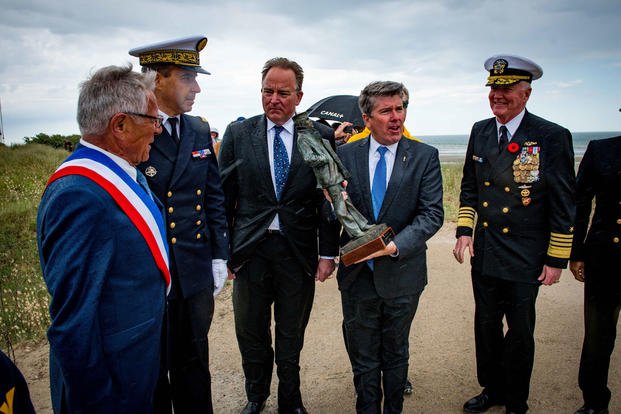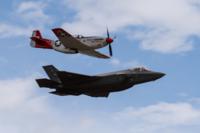SAINTE-MARIE-DU-MONT, France -- In the midst of the 75th Anniversary of D-Day, Adm. James G. Foggo III, commander of U.S. Naval Forces Europe and Africa (CNE-A), and the U.S. Navy Memorial teamed up to dedicate The Lone Sailor statue at Utah Beach, June 6.
The Lone Sailor is an iconic symbol of the Navy Memorial's mission to Honor, Recognize, and Celebrate the men and women of the Sea Services, past, present, and future and to inform the public about their service. The statue at Utah Beach is the first one located outside the United States.
"The newest location was chosen to honor the ‘Frogmen’ of the Naval Combat Demolition Units and all of the men and women of the Navy who heroically served at Normandy to defend freedom for the United States and our allies," said retired Rear Adm. Frank Thorp IV, president and CEO of the U.S. Navy Memorial.
In the predawn hours of June 6, 1944, they were the first Americans to set foot on to the shores of France as part of Operation Neptune. It was the largest seaborne invasion in history and part of an overarching plan code-named Operation Overlord - the beginning of the end of World War II (WWII) in Europe, and commonly referred to as D-Day.
"The Frogmen swam ashore to the beaches of Normandy to make them safer for the follow-on wave of Allied forces," said Foggo. "The Lone Sailor statue is a reminder to honor and remember their bravery and to act as a link from the past to the present as we continue to protect the same values they fought to protect."
These Frogmen, the ancestors of today's SEALs, came onto the beaches to dismantle and demolish mines and anti-ship barriers in preparation for the amphibious landing of the 1st Army Division on June 6, 1944.
"This statue will serve as a reminder of the historic day the United States and Allies arrived from the sea to free the world from tyranny and repression, forging a lasting relationship with the people of Saint- Marie-Du-Mont, the first city to be liberated in France during WWII," Foggo said.
The Lone Sailor statue stands on a plaza at the Utah Beach Museum overlooking the Atlantic Ocean from where the U.S. invasion force appeared on that historic morning. Although people come and go from this statue, the Lone Sailor will continue to serve as a universal sign of respect towards all Sea Service personnel for generations to come.
CNE-A Fleet Master Chief Derrick Walters, a Navy SEAL, will participate in a swim that will emulate the journey the Frogmen took in the early morning of June 6, 1944. "It is an honor to be here for 75th Anniversary of D-Day, but also to participate in a dedication ceremony that honors the Frogmen's contribution and legacy is a once in a life opportunity and a very special moment for me and the Navy family."
The first Lone Sailor statue, the work of sculptor Stanley Bleifeld, was dedicated in October 1987. The Navy Memorial's Statue City Program began in 1997 with the placement of a Lone Sailor statue at Recruit Training Command in Great Lakes, IL. The Lone Sailor in Normandy is the seventeenth, including the original on the Navy Memorial Plaza in Washington, DC.
"The Lone Sailor monument represents all these Sailors and Marines that lost their lives at sea. And what they have given to us," said Foggo. "Their steadfast commitment defeated tyranny and preserved freedom. To them, we are forever indebted.
U.S. Naval Forces Europe - Africa, headquartered in Naples, Italy, conducts a full range of maritime security operations and theater security cooperation missions in concert with coalition, joint, interagency, and other parties in order to advance security and stability in Europe and Africa.















